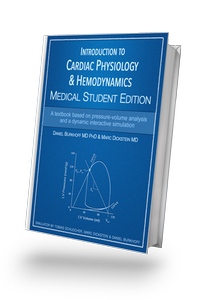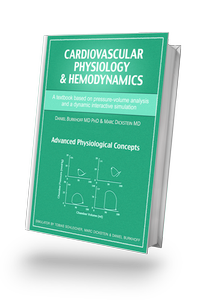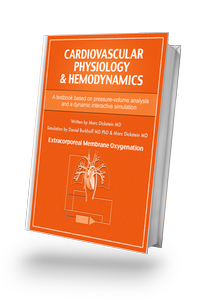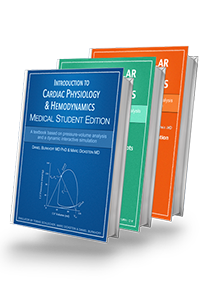Student
An introduction to the key concepts. For students of all levels

Part 1. The Basics
Cardiac Cycle
Time Varying Elastance
Preload
Afterload
Contractility
Lusitropy
Frank-Starling Relations
Part 2: Introduction to Cardiac Pathology
Aortic Stenosis
Aortic Insufficiency
Mitral Stenosis
Mitral Insufficiency
Coronary Circulation
Heart Failure with Reduced EF (HFrEF)
Heart Failure with Preserved EF (HFpEF)
Cardiogenic Shock (CGS)
Pericardial Physiology
Part 3: Introduction to Oxygen Delivery and the ABG
Oxygen
The 5 causes of Hypoxemia
Carbon Dioxide
The ABG
Oxygen Delivery Tutorial
Part I: Basics of Pressure-Volume Analysis
Chapter 1: The Cardiac Cycle
Chapter 2: Pressure-Volume Relations
Chapter 3: Preload
Chapter 4: Afterload
Chapter 5: Contractility
Chapter 6: Lusitropy
Chapter 7: Frank-Starling Relations
Part II: Introduction to Cardiac Pathology
Chapter 1: Valve Diseases
Chapter 2: Coronary Circulation
Chapter 3: Heart Failure
Chapter 4: Pericardial Physiology
Part III: Oxygen Delivery and the ABG
Chapter 1: Oxygen in Lungs: Alveolar Gas Equation
Chapter 2: Oxygen in Blood: O2-Hb dissociation curve
Chapter 3: Oxygen in Blood: O2 content
Chapter 4: Aa gradient: Diffusion Abnormality
Chapter 5: Aa gradient: Shunt
Chapter 6: Aa gradient: VQ mismatch
Chapter 7: Ventilation and CO2
Chapter 8: Intro to the ABG
Chapter 9: Fick Equation
Chapter 10: Oxygen Delivery and SVO2
Basic Cardiovascular simulation
Basic Pathophysiology
Ability to save conditions you create
Advanced
For a deeper dive. Especially for trainees in cardiology

Basic Concepts from Cells to Chambers
Introduction
Anatomy
The Circulatory Loop
Cardiac Muscle Physiology
Organ Level Physiology
Basic Physiology with the PV LOOP (Lessons and Tutorials)
The Cardiac Cycle and Pressure-Volume Loops
Pressure-Volume Relations
Preload
Afterload
Contractility
Lusitropy
Starling Curves
Ventricular-Vascular Interactions
Right Ventricular Mechanics
Atrial Mechanics
The Pericardium and Ventricular Interactions
Normal Valve Function and Flow Patterns
Advanced Concepts from Cells to Chambers and Control Mechanisms
Excitation-Contraction Coupling
Determinants of Myocardial Oxygen Consumption
Basics of Myocardial Metabolism
Regulation of Coronary Blood Flow
Autonomic Control of the Circulation
Basics of Cardiovascular Receptor Biology and Pharmacology
Exercise Physiology
Appendix
Invasive Assessment of Pressure-Volume Relations
Noninvasive Estimation of Pressure-Volume Relations
Part I: Basics of Pressure-Volume Analysis
Chapter 1: The Cardiac Cycle
Chapter 2: Pressure-Volume Relations
Chapter 3: Preload
Chapter 4: Afterload
Chapter 5: Contractility
Chapter 6: Lusitropy
Chapter 7: Frank-Starling Relations
Part II: Introduction to Cardiac Pathology
Chapter 1: Valve Diseases
Chapter 2: Coronary Circulation
Chapter 3: Heart Failure
Chapter 4: Pericardial Physiology
Advanced cardiovascular simulation with ability to simulate all forms of heart failure, valve diseases, coronary artery disease, understand myocardial energetics and introduce and vary settings of a variety of mechanical support devices and basic set of intravenous pharmacologic agents
Extensive Try-It-Now libraries
The Patient Simulator
Ability to save, recall and share parameter sets
ECMO
Essential physiology for all practitioners involved in ECMO and MCS

Quick Review of KEY aspects of Cardiac Function
Quick review of the PV Loop: Preload, Afterload, Contractility
Quick Review of Gas Exchange and O2 Delivery
Oxygen
The 5 causes of Hypoxemia
Carbon Dioxide
The ABG
Oxygen Delivery Tutorial
VV ECMO - The Basics
Basic V-V ECMO Physiology
ECMO Device Hemodynamics
Recirculation
VA ECMO and Acute MCS
Basic V-A ECMO Physiology, Harlequin Syndrome
Ventricular afterload and VA ECMO
IABP and VA ECMO
Direct LV decompression (vent and transvalvular pump)
RV Function and PAHTN: ECMO, RVAD, ASD
Part III: Oxygen Delivery and the ABG
Chapter 1: Oxygen in Lungs: Alveolar Gas Equation
Chapter 2: Oxygen in Blood: O2-Hb dissociation curve
Chapter 3: Oxygen in Blood: O2 content
Chapter 4: Aa gradient: Diffusion Abnormality
Chapter 5: Aa gradient: Shunt
Chapter 6: Aa gradient: VQ mismatch
Chapter 7: Ventilation and CO2
Chapter 8: Intro to the ABG
Chapter 9: Fick Equation
Chapter 10: Oxygen Delivery and SVO2
Physiology of ECMO
Membrane Lung Dysfunction Lecture
LV distension on ECMO
Cardiovascular Pharmacology
Surgical Approaches to PA HTN
Ability to vary a host of device and patient pulmonary and metabolic parameters with outputs that include regional blood gasses
A more advanced library of modeled conditions specific to lung failure and acute heart failure
Multiple cannulation configurations (VV, VA, VAV)
Ability to add other devices (trans-valvular pumps, IABP, LV vent)
Complete
A compilation of all the licenses

ALL BOOKS
ALL LESSONS
FULL SIMULATOR
Professor
Includes all Harvi books, lessons, and simulator input/output/graphing. Additional features are listed below.
Able to download 42 time-domain signals (5 ms resolution) in csv format to export to excel or graphing programs
Allows real time graphics on two different screens; second screen only displays graphics for use in teaching sessions
Zoom orientation sessions to help get up and running and direct email support
A Harvi Site License provides unlimited University-wide access to Harvi through the institution’s single sign on (SSO) system.
This allows all faculty and students to access Harvi through a unique URL (e.g., universityname.harvi.online) with their University username and password.